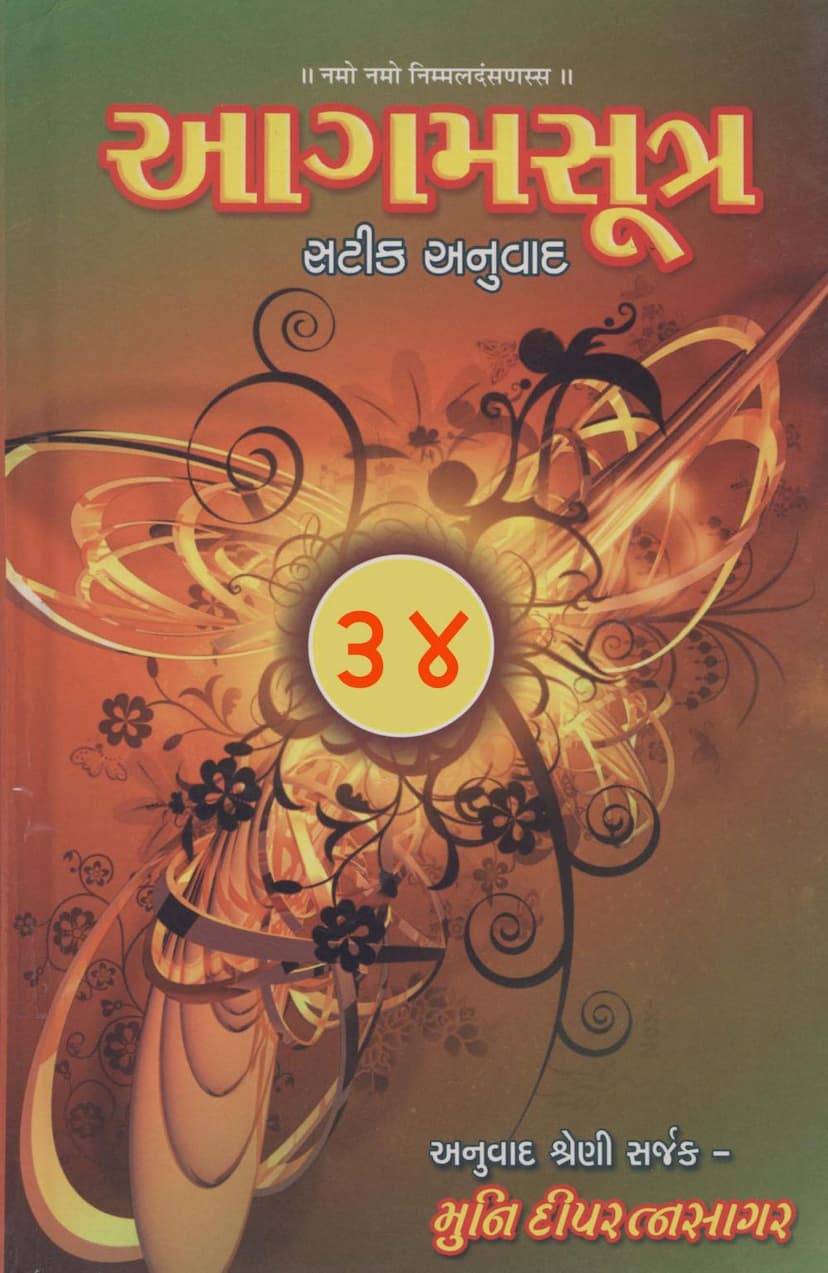Agam Satik Part 34 Aavashyak Sutra Gujarati Anuwad 4
Added to library: September 1, 2025

Summary
Here's a comprehensive summary of the provided Jain text, "Agam Satik Part 34 Aavashyak Sutra Gujarati Anuwad 4," based on the text provided:
Book Title: Agam Satik Part 34 Aavashyak Sutra Gujarati Anuwad 4 Author(s): Dipratnasagar, Deepratnasagar Publisher: Deepratnasagar
Overall Purpose and Content:
This book is Volume 34 of a larger series titled "Agam Satik Anuwad" (Commentaried Translation of Agamas), specifically focusing on the Aavashyak Sutra. The text is a Gujarati translation and commentary of the Aavashyak Sutra, a foundational text in Jainism. This particular volume covers the latter part of the Aavashyak Sutra's commentary, starting from Niryukti (commentary) number 1274 and concluding with Niryukti number 1622. It also includes the final sections of Study 4 (Adhyayan 4) and completes Study 6 (Adhyayan 6), thus finishing the entire Aavashyak Sutra with commentary and translation.
Key Themes and Sections:
The core of the Aavashyak Sutra deals with the six essential duties (Aavashyakas) of a Jain monk and highlights the path to spiritual liberation. This volume delves deeply into the philosophical and practical aspects of these duties, often through extensive allegorical stories and detailed explanations of Jain principles.
Detailed Summary of Content (Based on the provided text's narrative flow):
The text systematically goes through the Aavashyak Sutra, explaining each aspect with detailed Niryukti (commentaries) and often through illustrative stories. Based on the extensive detail within the provided text, particularly in the latter pages, the summary can be broken down into the following:
- Detailed Explanation of Principles (Niryuktis and Commentary): The majority of the text consists of the commentary (Niryukti) on various verses and concepts within the Aavashyak Sutra. These explanations are highly elaborate and often include:
- Ethical Conduct and Observances: Detailed discussions on the conduct expected of ascetics, covering a wide range of situations and potential transgressions.
- Philosophical Concepts: Explanations of core Jain concepts like karma, soul, liberation, right faith (Samyak Darshan), right knowledge (Samyak Gyan), and right conduct (Samyak Charitra).
- Ascetic Practices: Detailed descriptions of various practices, including yoga, meditation (Dhyan), fasting, and the importance of adhering to vows.
- The "Thirty-Two Yoga Collections" (Thirty-two categories of practices leading to spiritual progress): The text extensively elaborates on these thirty-two points, providing stories and examples for each, which are crucial for understanding the path of liberation. These include:
- Aalochana (Confession): The importance of confessing one's faults to the spiritual preceptor.
- Nirapalaap (Not Revealing to Others): The need for discretion and not divulging the faults confessed.
- Dridhatva in Adversity: Maintaining steadfastness in Dharma during difficult times.
- Anishrit Upadhan: Performing austerities without dependence on external outcomes.
- Shiksha: The act of learning and practicing the teachings.
- Nirpratikraman: Non-violation of conduct.
- Agyanta: Acting without seeking recognition.
- Alobha: Non-greed.
- Titisksha: Forbearance and tolerance.
- Arjava: Straightforwardness and honesty.
- Suchi: Purity and cleanliness.
- Samyakdrushti: Right Vision or perspective.
- Samadhi: Mental equanimity.
- Ayararopana: Adherence to conduct.
- Vinayoga: Humility and respect.
- Samvega: Spiritual urgency and detachment from worldly pleasures.
- Dhrutimati: Firmness of mind.
- Prasnidhi: Right intention.
- Suvidhi: Proper execution of duties.
- Samvara: Restraint of influx of karma.
- Aatmadosha: Recognizing and correcting one's faults.
- Sarva Kaam Virakti: Detachment from all desires.
- Pratyakhyan: Renunciation and abstention.
- Vyutsarga: Relinquishment.
- Aprmada: Non-negligence.
- Lavalaav: Minute-by-minute awareness.
- Dhyana Samvara Yoga: Performing yoga for karma restraint.
- Maranantika: Facing death with equanimity.
- Sangraha Parijna: Understanding and renouncing attachment.
- Pratikhhyan Parijna: Renunciation of future actions.
- Prayashchitta: Penance and atonement.
- Aaradhana: Devoted practice, especially at the time of death.
- Illustrative Stories (Kathas): The text is rich with stories, often lengthy and detailed, featuring kings, queens, merchants, monks, and even divine beings. These stories serve to illustrate the karmic consequences of actions, the importance of ethical conduct, the path to spiritual realization, and the various ways in which principles are applied in life. These stories often span multiple Niryuktis.
- Legal and Procedural Aspects: The text delves into specific rules and procedures related to monastic life and the conduct of the laity, covering details of behavior, speech, and thought processes.
- The Importance of the Guru: The text repeatedly emphasizes the role of the Guru (spiritual preceptor) in guiding the disciple through the spiritual path and the importance of respecting and following their teachings.
- The Nature of Karma: Many stories implicitly or explicitly illustrate the working of karma, showing how actions in this life lead to consequences in the future.
- Detailed Analysis of Aavashyakas: The six essential duties (Samayika, Chaturvimsati-stava, Vandan, Pratikraman, Kayotsarga, and Pratyakhyan) are thoroughly explained and analyzed, with a focus on the internal and external aspects of these practices.
Structure and Presentation:
- Niryukti-Based Commentary: The primary structure follows the commentaries (Niryuktis) on the Aavashyak Sutra, starting from a specific number and progressing sequentially.
- Elaborate Examples: The use of numerous stories and anecdotes makes the complex philosophical and ethical principles more accessible.
- Detailed Explanations of Conduct: The text provides granular details on how to behave in various situations, often covering subtle nuances of right conduct.
Significance:
This volume is a comprehensive resource for understanding the Aavashyak Sutra in its entirety, including the intricate commentaries that have been passed down through generations. It highlights the depth of Jain philosophy and the rigorous ethical and spiritual path prescribed for ascetics. The stories serve as moral lessons and illustrate the practical application of Jain teachings.
Overall Impression:
The provided text is a dense and scholarly work, meticulously detailing the nuances of Jain monastic and ethical conduct through the lens of the Aavashyak Sutra and its extensive commentaries. It reflects a deep commitment to preserving and explaining the Jain tradition.